Audi Q7
The Audi Q7 is a mid-size luxury SUV made by the German manufacturer Audi, unveiled in September 2005 at the Frankfurt Motor Show. Production of this seven-seater SUV began in the autumn of 2005 at the Volkswagen Bratislava Plant in Bratislava, Slovakia.[2] It was the first SUV offering from Audi and went on sale in 2006. Later, Audi's second SUV, the Q5, was unveiled as a 2009 model. Audi has since unveiled a third SUV model, the Q3, which went on sale in the third quarter of 2011. The Q7 shares a Volkswagen Group MLB platform and chassis with the Bentley Bentayga, Lamborghini Urus, Porsche Cayenne and the Volkswagen Touareg.
| Audi Q7 | |
|---|---|
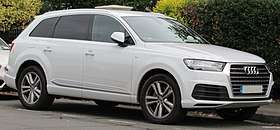 | |
| Overview | |
| Manufacturer | Audi AG |
| Production | November 2005 – present[1] |
| Body and chassis | |
| Class | Mid-size luxury crossover SUV |
| Body style | 4-door SUV |
| Layout | Longitudinal F4 layout (quattro) |
| Related | Porsche Cayenne Volkswagen Touareg Audi Q8 Bentley Bentayga |
First generation (Typ 4L: 2006-2015)
| Audi Q7 (4L) | |
|---|---|
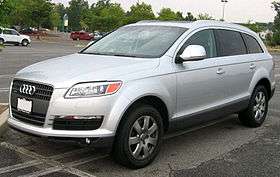 Pre-facelifted Audi Q7 | |
| Overview | |
| Manufacturer | |
| Production | November 2005–2015 |
| Assembly |
|
| Designer | Satoshi Wada (Concept design: 2002; Production: 2003)[5][6] |
| Body and chassis | |
| Platform | Volkswagen Group PL71 platform |
| Related | Porsche Cayenne Volkswagen Touareg |
| Powertrain | |
| Engine | petrol 3.0L V6 T FSI 3.6L VR6 FSI 4.2L V8 FSI Diesel 3.0L V6 TDI 4.2L V8 TDI 6.0L V12 TDI |
| Transmission | 6-speed automatic 8-speed ZF 8HP Automatic |
| Dimensions | |
| Wheelbase | 3,002 mm (118.2 in) |
| Length | 5,085 mm (200.2 in) |
| Width | 1,984 mm (78.1 in) |
| Height | 1,737 mm (68.4 in)[7] |
Overview
The Q7 (internally designated Typ 4L) utilizes a modified version of the Volkswagen Group PL71 platform. Previewed by the Audi Pikes Peak quattro concept car, the Q7 is designed more for on-road use, and was not meant for serious off-road use where a transfer case is needed. In an off-road test through the Australian outback it fared well for a "soft roader".[8]
Although it lacks a low-range transfer case, it has quattro permanent four-wheel drive system with a central locking differential, and a self-levelling air suspension with Continuous Damping Control, called Adaptive air suspension, which helps in off-road situations.
Development began in 2002 under the code AU 716, primarily focused on the Pikes Peak Concept. Design work was frozen for the Concept in July 2002, for presentation at the North American International Auto Show in January 2003. Following the introduction of the concept, full-scale development began on Typ 4L of the PL71 platform.
The production design was frozen in late 2003, for a late 2005 start of production. Prototypes went into testing in 2004, with development concluding in the first half of 2005. It introduced the world's only series production passenger car V12 TDI diesel engine. While the Q7 has been the flagship SUV in Audi's product portfolio, a top-of-the-line coupé model, called the Audi Q8, was released for sale in 2018. It debuted in its concept form at the 2017 Detroit auto show.
Sales
| Year | European sales | US Sales | Canada sales[9] |
| 2005 | 434 | – | - |
| 2006 | 33,044 | 10,003 | 618 |
| 2007 | 41,064 | 20,695 | 1,235 |
| 2008 | 30,000 | 13,209 | 1,269 |
| 2009 | 12,616 | 7,299 | 1,146 |
| 2010 | 12,455 | 7,976 | 1,247 |
| 2011 | 12,882 | 8,998 | 1,565 |
| 2012 | 11,513 | 11,008 | 1,653 |
| 2013 | 11,037 | 15,978 | 1,781 |
| 2014 | 10,491 | 18,517 | |
| 2015 | 20,698 | 18,995 | |
| 2016 | 33,358 | 30,563 | |
| 2017 | 30,351 | 38,346 | |
| 2018 | 23,213 | 37,417 | |
| 2019 | 34,649 |
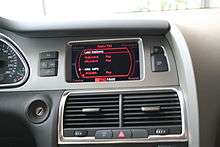
Features
- Q7 offers an optional feature marketed as Audi Music Interface (AMI), to allow user manipulation of an iPod or similar MP3-style player, which can play through the Multi Media Interface.
- Q7 was the first Audi model to offer Side Assist, a type of blind-spot detection and warning system.
Engines
Source[10]
| Petrol engines | |||
|---|---|---|---|
| Model | Year | Engine type | Power, torque at rpm |
| 3.6 FSI | 2008–2009 | 3,597 cc (3.597 L; 219.5 cu in) VR6 FSI | 280 PS (206 kW; 276 hp) at 6,200, 36.7 kg⋅m (360 N⋅m; 265 lb⋅ft) at 2,500–5,000 |
| 4.2 FSI | 2008–2009 | 4,163 cc (4.163 L; 254.0 cu in) V8 FSI | 350 PS (257 kW; 345 hp) at 6,800, 440 N⋅m (325 lb⋅ft) at 3,500 |
| Diesel engines | |||
| Model | Year | Engine type | Power, torque at rpm |
| 3.0 TDI | 2005–2007 | 2,967 cc (2.967 L; 181.1 cu in) V6 turbo | 233 PS (171 kW; 230 hp) at 4,000, 500 N⋅m (369 lb⋅ft) at 1,750–2,750 |
| 3.0 TDI | 2007–2009 | 2,967 cc (2.967 L; 181.1 cu in) V6 turbo | 240 PS (177 kW; 237 hp) at 4,000–4,400, 550 N⋅m (406 lb⋅ft) at 2,000–2,250 |
| 3.0 TDI clean diesel | 2009– | 2,967 cc (2.967 L; 181.1 cu in) V6 turbo | 240 PS (177 kW; 237 hp) at 4,000–4,400, 550 N⋅m (406 lb⋅ft) at 2,000–2,250 |
| 4.2 TDI | 2007–2009 | 4,134 cc (4.134 L; 252.3 cu in) V8 turbo | 326 PS (240 kW; 322 hp) at 3,750, 760 N⋅m (561 lb⋅ft) at 1,800–2,500 |
| 6.0 TDI CCGA | 2008– | 5,934 cc (5.934 L; 362.1 cu in) V12 twin turbo | 500 PS (368 kW; 493 hp) at 3,750, 1,000 N⋅m (738 lb⋅ft) at 1,750–3,250 |
0–100 km/h performance for Q7 3.6 VR6 FSI is 8.5s, 4.2 V8 FSI is 7.4s and for 6.0 V12 TDI is 5.5s.
Safety
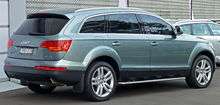
Despite its multiple airbags and safety electronics, such as Electronic Stability Programme (ESP), the Q7 scored only four stars out of five (![]()
![]()
![]()
![]()
![]()
However, in the United States, the Q7 received five out of five stars (![]()
![]()
![]()
![]()
![]()
The 2015 Q7 has a rollover risk of 18.5%.[13]
| Euro NCAP test results | ||
|---|---|---|
| Audi Q7, Large Off-Road (2015)[14] | ||
| Test | Points | % |
| Overall: | ||
| Adult occupant: | 36 | 94% |
| Child occupant: | 43 | 88% |
| Pedestrian: | 25 | 70% |
| Safety assist: | 10 | 76% |
| Category | Rating |
|---|---|
| Moderate overlap frontal offset | Good |
| Side impact | Good |
North American models
It was first released as 2007 model, with Q7 4.2 quattro available at launch.[16]
Q7 hybrid (2005)
The Q7 hybrid is a concept vehicle using the engine from the 4.2 FSI with an electric motor to provide 200 N⋅m (148 lb⋅ft) extra torque, and nickel-metal hydride battery. It has 0–100 km/h (62 mph) acceleration time of 6.8 seconds. The vehicle weighs 2,410 kg (5,313 lb), 140 kg (309 lb) heavier than the petrol counterpart.
The vehicle was unveiled at the 2005 Frankfurt Motor Show.[17]
Audi reportedly was going to introduce a hybrid version of the Q7 sometime in the future.[18] However, the low US dollar caused Audi to drop the plans for the US market, but stated limited quantities would be available for the commercial market.[19] Audi's research and development chief, Michael Dick, later announced Q7 hybrid would be produced in limited numbers for test purposes only and that development work would focus on a more advanced lithium-ion battery-based hybrid system for the Q5.[20]
Q7 3.0 TDI clean diesel (2010)
The Q7 3.0 TDI clean diesel is a version of the 3.0 V6 TDI with selective catalytic reduction. The engine was later used in the next generation of the Q7 for the European market. The 3.0-litre TDI S line can accelerate from 0–60 mph (97 km/h) in 8.4 seconds and has a top speed of 134 mph (215.7 km/h).[21]
US models of the 2009 Audi Q7 TDI Premium went on sale in 2009–04 with a base MSRP of $50,900 (excluding a destination charge of $825, taxes, title or dealer charges).[22]
Q7 4.2 TDI (2007–2009)
The vehicle was unveiled at the 2007 Geneva Motor Show.
The production version went on sale in early summer 2007.[23]
Q7 V12 TDI (2008–2012)
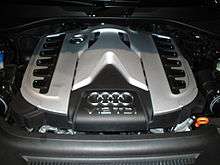
.jpg)
.jpg)
The V12 TDI engine was "based" on the diesel technology from Audi R10 TDI race car, though both engines are completely unrelated: the bore / stroke / angle of the blocks are different and they do not share a single component. The only twelve-cylinder diesel engine used in any passenger car, it was rated at 500 PS (368 kW; 493 hp) and 1,000 N⋅m (738 lb⋅ft) of torque. This gives the vehicle a 0–100 km/h (62 mph) acceleration time of 5.5 seconds. The Q7 V12 TDI is, according to Audi, the best handling Q7 due to a revised suspension, tires and brakes. Audi claims the Q7 V12 TDI can handle a lateral acceleration of over .9 g on a 300-foot (91 m) skid-pad.[24]
The concept vehicle originally appeared at the 2006 Paris Motor Show.
Audi had announced V12 diesel version for the US market using diesel emission treatment technology jointly developed with Volkswagen and Mercedes-Benz under the label "BlueTec".[25] Audi cancelled the plan to federalize the Q7 V12 TDI for the US market due in part to the global financial crisis of 2008.[26]
This V12 version is no longer available for the model year 2013 in anticipation of the cosmetic and mechanical update of Q7 for 2014. The auto listing websites, mobile.de[27] and autoscout24.de,[28] have shown the 2012 model year availability of V12 version.
Audi Q7 coastline (2008)
The Audi Q7 coastline is a concept version of the Q7 V12 TDI that features an Inuit white interior with wood decoration. The design theme was inspired by luxury yachts.[29]
The vehicle was unveiled at the 2008 Geneva Motor Show.[30]
Lawsuit on the use of the letter Q
In early 2005, Nissan North America Inc. filed a lawsuit against Audi over the use of the letter "Q" as a model name.[31]
Audi is using the "Q" for the designation of their quattro four-wheel drive system, used in production cars for over twenty-five years (Audi's quattro trademark is actually an umbrella term for several types of four wheel drive systems developed by Torsen, Haldex Traction AB, and Borg-Warner, the latter being used in the Q7). Nissan's Infiniti marque had been using Q as the name for passenger cars (the Q50) and QX for SUVs (the QX50 and QX70) since 2013.
A settlement between Audi AG and Nissan was reached in late 2006. The agreement stipulates that Audi will only use the Q-prefix for three models, the Q3, Q5 and the Q7.
Facelift (2010–2015)
_front_20110115.jpg)
The vehicle was unveiled at the 2009 Pebble Beach Concours d'Elegance.[32]
Exterior changes include new front and rear lights which better incorporate LED lighting with optional LED turn signals and daytime running lights, new wheel designs, chrome accents, four new paint colors, and updated body styling in the front and rear.
A redesigned interior includes a new instrument cluster, new leather seating, ambient door lighting, new interior color choices, new trim, and the third generation MMI control system.[33]
Q7 3.0 TDI clean diesel quattro (2009–2015)

It is a version of 3.0 TDI with selective catalytic reduction. CO2 emission was reduced to 234 g/km with Euro 6 certification, but the vehicle is 50 kg (110 lb) heavier.
Per Popular Mechanics 01 Oct. 2009. At 72.5MPH with a RPM of 2,200 - 2,500 (the sweet spot of the top 6th gear), the car achieved a 29.6 MPG of diesel. The 8-speed transmission, available 2011 and later, was 11-14% more fuel efficient than the previous 6-speed transmission (available since 2009-2010 model year) in U.S. models.
Q7 2011
A brand new facelift brought optional LED headlights, an 8-speed transmission, start/stop fuel-saving technology, CO2 rating reduced to 195 g/km, and a wraparound tailgate design. Also more flat and metallic colors became available and 21-inch titanium-effect wheels became an optional extra. Certain models now achieved upwards of 37 MPG IMP. New Engines include 2 3.0 supercharged engines. One of the supercharged engines puts out 272 hp (203 kW) and 295 lb⋅ft (400 N⋅m) of torque. The other engine which is found on the S-line prestige Q7 puts out 333 hp (248 kW) and 325 lb⋅ft (441 N⋅m) of torque and is the twin of the engine found in the S4 and S5 cabrios. These engines replaced both the 3.6 and 4.2 L gasoline engines. Both engines have the same fuel economy.
Q7 2012
Audi has added their new Audi Connect to the MMI system, which adds internet-driven POI search, via user input or via the voice control system, as well as access to online services delivering local fuel prices, news, weather and other information. Audi Connect also offers in-car WiFi connectivity for up to 8 devices.
2012 was the last model year for the V12 version.
US models
The vehicles were introduced in 2006 as 2007 models. Available models include 3.6 FSI quattro and 4.2 FSI quattro.
Changes include standard LED taillights with available LED turn signals and daytime running lights and SIRIUS traffic system.
The production version went on sale in September 2006.[34]
For 2011, the 3.6 FSI and 4.2 FSI engines were replaced by two 3.0 L TFSI supercharged engines. The base version develops 272 hp (203 kW) (280 hp (209 kW) for 2012) and 295 lb⋅ft (400 N⋅m) of torque, while the S-Line has 333 hp (248 kW) and 325 lb⋅ft (441 N⋅m) of torque.
The V12 Diesel engine is not available in the United States.
Engines
| Petrol engines | |||
|---|---|---|---|
| Model | Year | Engine type | Power, torque at rpm |
| 3.0 TFSI quattro | 2010– | 2,995 cc (2.995 L; 182.8 cu in) supercharged V6 FSI | 272 PS (200 kW; 268 hp) at 4,750–6,500, 400 N⋅m (295 lb⋅ft) at 2,150–4,780 |
| 3.0 TFSI quattro S-Line | 2010– | 2,995 cc (2.995 L; 182.8 cu in) supercharged V6 FSI | 333 PS (245 kW; 328 hp) at 5,500–6,500, 440 N⋅m (325 lb⋅ft) at 2,900–5,300 |
| 3.6 FSI quattro | 2010– | 3,597 cc (3.597 L; 219.5 cu in) VR6 FSI | 280 PS (206 kW; 276 hp) at 6,200, 360 N⋅m (266 lb⋅ft) at 2,500–5,000 |
| 4.2 FSI quattro | 2010– | 4,163 cc (4.163 L; 254.0 cu in) V8 FSI | 350 PS (257 kW; 345 hp) at 6,800, 440 N⋅m (325 lb⋅ft) at 3,500 |
| Diesel engines | |||
| Model | Year | Engine type | Power, torque at rpm |
| 3.0 TDI quattro | 2009– | 2,967 cc (2.967 L; 181.1 cu in) V6 turbo | 240 PS (177 kW; 237 hp) at 4,000–4,400, 550 N⋅m (406 lb⋅ft) at 2,000–2,250 |
| 4.2 TDI quattro | 2009– | 4,134 cc (4.134 L; 252.3 cu in) V8 twin turbo | 340 PS (250 kW; 335 hp) at 4,000, 760 N⋅m (561 lb⋅ft) at 1,750–3,000 |
| 6.0 TDI quattro | 2009– | 5,934 cc (5.934 L; 362.1 cu in) V12 twin turbo | 500 PS (368 kW; 493 hp) at 3,750, 1,000 N⋅m (738 lb⋅ft) at 1,750–3,250 |
Transmission
All models include 6-speed Tiptronic automatic transmission as standard. A 6 speed manual transmission was offered only in Europe on the first generation Q7 with the 3.6 liter engine. From 2010 (2011 model year in the U.S.), 8-speed automatic transmission is standard
Second generation (Typ 4M; 2015–present)
| Audi Q7 (4M) | |
|---|---|
_%E2%80%93_Frontansicht%2C_3._Januar_2016%2C_D%C3%BCsseldorf.jpg) | |
| Overview | |
| Production | 2015–present |
| Model years | 2016–present |
| Assembly |
|
| Designer | Wolfgang Egger (2012, 2013) |
| Body and chassis | |
| Body style | 4-door SUV |
| Platform | Volkswagen Group MLBevo platform[35] |
| Related | Porsche Cayenne Volkswagen Touareg Audi Q8 Bentley Bentayga Lamborghini Urus |
| Powertrain | |
| Engine | petrol 2.0 L I4 TFSI 2.0 L I4 TFSI PHEV system (Asian Market) 3.0 L VW EA 839 (CZSE) V6 TFSI 3.0 L VW EA 839 (CZSE) V6 (Hybrid System) PHEV Diesel 3.0L V6 TDI 3.0L V6 TDI PHEV system (Q7 e-tron) 4.0L V8 TDI twin-turbo sequential-charging and an electric compressor (EPC) Supercharger (SQ7 TDI) |
| Transmission | 6-speed automatic 8-speed ZF 8HP Automatic |
| Dimensions | |
| Wheelbase | 2,994 mm (117.9 in) |
| Length | 5,052 mm (198.9 in) |
| Width | 1,968 mm (77.5 in) |
| Height | 1,741 mm (68.5 in) |
| Curb weight | 1,910–2,445 kg (4,210–5,390 lb) |
_%E2%80%93_Heckansicht%2C_3._Januar_2016%2C_D%C3%BCsseldorf.jpg)
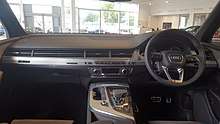
The second generation Audi Q7 was unveiled in January 2015 at the North American International Auto Show in Detroit.[36] The diesel- and petrol-powered versions were released for retail sales in 2015, followed shortly by diesel-powered plug-in hybrid variant, which is sold in Europe and will be available in the U.S.[37] but not in Canada.[38]
The plug-in hybrid, called the Q7 e-tron TDI Quattro, is powered by a 3.0 TDI V6 turbodiesel engine mated with an electric motor-generator placed in the 8-speed automatic gearbox to provide a maximum output power of 190 kW (255 hp) and a maximum torque of 600 N⋅m (443 lbf⋅ft) four-wheel drive.[39] An electronically controlled clutch can disconnect the V6 engine from the rest of the powertrain.[39] The 94 kW (126 hp) electric motor is powered by a 17.3 kWh lithium-ion battery capable of delivering an all-electric range of 54 to 56 km (34 to 35 mi). The Q7 e-tron produces CO
2 emissions between 50 and 48 g/km, and has a fuel consumption of 1.8 to 1.9 l/100 km (160 to 150 mpg‑imp; 130 to 120 mpg‑US) under the New European Driving Cycle (NEDC).[40] The Q7 e-tron accelerates from zero to 100 km/h (62.1 mph) in 6.2 seconds in hybrid mode, and 0–60 km/h (37.3 mph) in 6.5 seconds in all-electric mode. Its top speed in hybrid mode is 230 km/h (143 mph) and 135 km/h (84 mph) in electric mode.[40]
Audi announced a Q7 e-tron TFSI at the 2015 Shanghai motor show, developed specially for Asian markets (China, South Korea, Singapore and Japan). Its 2.0 TFSI and electric motor deliver 270 kW (367 hp) and 700 Nm (516.3 lb-ft) of system torque – enough to accelerate from 0 to 100 km/h (62.1 mph) in 5.9 seconds and for a top speed of 220 km/h (136.7 mph). The standard consumption of 2.5 liters of fuel (94.1 US mpg) corresponds to CO2 emissions of less than 60 grams per kilometer (96.6 g/mi). All-electric range will be up to 53 km (33 mi).[41][42]
The Audi Q7 2.0 TFSI (1984 cc, 185 kW / 252 hp) is also available in the Russia, Canada, India and the Middle East.[43]
The first units of the diesel-powered Audi Q7 e-tron were registered in Germany in April 2015.[44] Cumulative sales of the plug-in hybrid in Germany totaled 344 units through April 2016.[45][46]
Markets
The second generation of the Q7 will be the first of the Q7 to be sold in Bangladesh.[47] For Marvel Studios' Captain America: Civil War Audi debuted a commercial for the SQ7 directed by the Russo brothers featuring unreleased scenes from the car chase feature in the film as well as providing several SQ7 and other vehicles for the film.[48]
Safety
| Euro NCAP test results | ||
|---|---|---|
| Audi Q7, Large Off-Road (2015)[49] | ||
| Test | Points | % |
| Overall: | ||
| Adult occupant: | 36 | 94% |
| Child occupant: | 43 | 88% |
| Pedestrian: | 25 | 70% |
| Safety assist: | 10 | 76% |
Engines
| Model | Year(s) | Displacement | Power | Torque | 0–100 km/h (0–62 mph) |
|---|---|---|---|---|---|
| Petrol engines | |||||
| 2.0 TFSI | 2016- | 1984 | 252 PS (249 hp; 185 kW) | 370 N⋅m (273 lbf⋅ft) | 6.9 s |
| 2.0 TFSI PHEV | 2016- | 1984 | 252 PS (249 hp; 185 kW) | 370 N⋅m (273 lbf⋅ft) | 6.9 s |
| 3.0 TFSI | 2015-2018 | 2995 | 333 PS (328 hp; 245 kW) | 440 N⋅m (325 lbf⋅ft) | 6.1 s |
| 3.0 TFSI | 2019- | 2995 | 340 PS (340 hp; 250 kW) | 450 N⋅m (332 lbf⋅ft) | 6.1 s |
| 55 TFSI e (PHEV system) | 2019- | 2995 | 381 PS (376 hp; 280 kW) | 600 N⋅m (443 lbf⋅ft) | 5.9 s |
| 60 TFSI e (PHEV system) | 2019- | 2995 | 456 PS (450 hp; 335 kW) | 700 N⋅m (516 lbf⋅ft) | 5.7 s |
| SQ7 | 2020– | 3956 | 510 PS (500 hp; 380 kW) | 770 N⋅m (568 lbf⋅ft) | 4.3 s |
| Diesel engines | |||||
| 3.0 TDI ultra | 2015-2018 | 2967 | 218 PS (215 hp; 160 kW) | 500 N⋅m (369 lbf⋅ft) | 7.1 s |
| 45 TDI | 2019- | 2967 | 231 PS (228 hp; 170 kW) | 500 N⋅m (369 lbf⋅ft) | 7.1 s |
| 3.0 TDI | 2015-2018 | 2967 | 272 PS (268 hp; 200 kW) | 600 N⋅m (443 lbf⋅ft) | 6.3 s |
| 50 TDI | 2019- | 2967 | 286 PS (282 hp; 210 kW) | 600 N⋅m (443 lbf⋅ft) | 6.3 s |
| e-tron | 2016-2018 | 2967 | 387 PS (382 hp; 285 kW) | 700 N⋅m (516 lbf⋅ft) | 6.2 s |
| SQ7 TDI | 2016- | 3956 | 435 PS (429 hp; 320 kW) | 900 N⋅m (664 lbf⋅ft) | 4.8 s |
2019 facelift


The Q7 was revised for 2019, introducing styling tweaks such as a redesigned grille, front and rear bumpers, new side sills, chrome trim for the tailgate and revised exhaust tips. It comes with two-tone paint as standard, which highlights the front splitter, side skirts, wheelarches and rear diffuser in anthracite., a range of mild-hybrid powertrains and refined chassis.
LED headlights are included as standard, Matrix LEDs or HD Matrix LEDs and Audi Laser Light are offered as additional cost options. The HD Matrix LEDs and Audi Laser Light combines automatic controlled high beam with small laser module in each unit to double the range of the Q7's full beam.
Air suspension as standard. Audi has also expanded the Q7's options list to include a new active roll-stabilisation system. It provide active anti-roll bars, controlled by a 48-volt electric motor that automatically adjust to reflect driving style and road conditions.
Three mild-hybrid 3.0-litre V6 powertrains are available, with the choice of two diesels and one petrol. The entry-level 45 TDI diesel produces 228 bhp and 500Nm of torque with a claimed 0-62 mph time of 7.1 seconds and a top speed of 142 mph. Mid-range 50 TDI models produce 282 bhp and 600Nm of torque, delivering a 0-62 mph of 6.3 seconds and a top speed of 150 mph. The 55 TFSI petrol model comes with 335 bhp and 500Nm of torque, with a claimed 6.0 seconds and a 155 mph electronically limited top speed. An eco-focused plug-in hybrid 55 TFSI e version will be introduced few months after initial sales.
Audi also offers a performance-focused SQ7 version, powered by a 429 bhp 4.0-litre V8 turbodiesel with 900Nm of torque; it has a claimed 0-62 mph time of 4.8 seconds and a limited top speed of 155 mph. The US model will use a V8 engine with the same displacement (shared with the US-market SQ8), albeit fueled by gasoline/petrol and producing 500bhp and 770Nm (568 lb-ft) of torque; it will go on sale in late spring 2020.[50]
Sales in the UK will start from September 2019.[51][52]
Sales in the Thailand will start from 2020.
See also
- Audi Duo
- Audi A4
- Multi Media Interface
References
- "Group dynamics at VW - Automotive Manufacturing Solutions". automotivemanufacturingsolutions.com. 1 July 2011. Retrieved 3 April 2018.
- "Audi Production in Ultramodern Bratislava Plant". worldcarfans.com. Retrieved 17 June 2010.
- Christian Steinert, The German Car Blog (22 August 2006). "Audi: New sales division in China". The German Car Blog. Retrieved 1 November 2010.
- "The Audi Q7 – Now, locally assembled". teambhp. Retrieved 8 November 2012.
- "Developing the Audi Q7". fourtitude.com. Retrieved 24 January 2015.
- "Satoshi Wada to open new design studio – Car Design News". cardesignnews.com. Retrieved 24 January 2015.
- Audi Q7 Dimensions Carsized.com
- Times Online
- "Audi Q7 North American sales figures". goodcarbadcar.com. Retrieved 2 March 2014.
- Audi.de as of June 2011
- "Audi A7 Reference". carautoportal.com. Archived from the original on 25 October 2009. Retrieved 26 June 2009.
- "IIHS-HLDI: Audi Q7". Iihs.org. 25 November 2008. Archived from the original on 28 November 2008. Retrieved 6 September 2009.
- "2015 Audi Q7 SUV AWD " National Highway Traffic Safety Administration (click Rollover)
- "Euro NCAP – Audi Q7 3.0 TDI quattro, LHD (2015)". euroncap.com. Retrieved 30 September 2015. Report
- "2015 Audi Q7 Large SUV / 2008 Audi Q7 3.6 4-door 4wd". IIHS. Retrieved 30 September 2015.
- "2007 Audi Q7 4.2 quattro Featuring Uncompromised SUV Performance, Luxury and Technology Priced at $49,900". Audiworld.com. 4 January 2006. Retrieved 17 October 2010.
- Frankfurt IAA – Audi Q7 Hybrid Concept Archived 5 January 2009 at the Wayback Machine
- Magda, Mike (12 October 2006). "Audi says hybrid future depends U.S. growth". Autobloggreen.com. Retrieved 17 October 2010.
- Vijayenthiran, Viknesh (24 March 2008). "Low dollar forces Audi to cancel U.S. Q7 hybrid plans". Motorauthority.com. Archived from the original on 28 June 2009. Retrieved 17 October 2010.
- Zoia, David E. (1 August 2008). "Audi Pulls Plug on Q7 Hybrid". Wardsauto.com. Retrieved 17 October 2010.
- "Audi Q7 Review". askaprice.com. 18 September 2014. Retrieved 18 September 2014.
- Harley, Michael (9 April 2009). "2009 Audi Q7 TDI priced at $50,900". Autoblog.com. Retrieved 17 October 2010.
- "The Audi Q7 4.2 TDI". Audiworld.com. Archived from the original on 18 September 2010. Retrieved 17 October 2010.
- "The World's Most Powerful Diesel Passenger Car". Audiworld.com. Retrieved 17 October 2010.
- Abuelsamid, Sam (28 February 2007). "Audi Q7 V12 TDI coming to America (maybe)!". Autoblog.com. Retrieved 17 October 2010.
- Vijayenthiran, Viknesh (10 October 2008). "Report: Audi will not sell the Q7 V12 TDI in U.S". Motorauthority.com. Archived from the original on 9 June 2009. Retrieved 17 October 2010.
- "Audi Q7 V12 Angebote bei mobile.de". mobile.de. Retrieved 1 April 2015.
- "Suchenergebnis". autoscout24.de.
- "2008: Spectacular Venue for the Audi Q7 Coastline to "Drop Anchor"". Audiworld.com. 2 December 2008. Retrieved 17 October 2010.
- "Audi Q7 Coastline Concept at Geneva". Worldcarfans.com. Retrieved 17 October 2010.
- "Audi Sued by Nissan Over Q". Audiworld.com. 26 March 2005. Retrieved 17 October 2010.
- Harley, Michael (26 August 2009). "Audi slaps Monroney on updated 2010 Q7". Autoblog.com. Retrieved 17 October 2010.
- "New Generation Audi Q7". Automoblog.net.
- "Used 2007 Audi Q7". Edmunds.com. Retrieved 13 February 2019.
- Audi Communication (1 April 2015). "Audi MediaServices – JPK Speech Hackenberg". audi-mediaservices.com. Archived from the original on 2 April 2015. Retrieved 1 April 2015.
- "Slimmer, Fuel-Efficient 2016 Audi Q7 To Bow at 2015 Detroit Auto Show". Edmunds. Retrieved 19 January 2015.
- Brandon Turkus (7 December 2014). "Audi Q7 to be first diesel plug-in from VW group". Autoblog.com. Retrieved 17 February 2015.
- Michel Deslauriers (14 December 2016). "Audi Forbidden Fruit: Q2, RS Q3 and Q7 e-tron TDI". Retrieved 15 September 2017.
- Duff, Mike (July 2016). "2017 Audi Q7 e-tron TDI Plug-In Hybrid". caranddriver.com. Hearst Communications. Retrieved 4 April 2017.
- Audi Media Center. "Audi Q7 e-tron 3.0 TDI quattro". Audi. Archived from the original on 28 May 2019. Retrieved 29 May 2016.
- "Audi introduces Q7 E-Tron 2.0 TFSI in Shanghai". autoblog.com. Retrieved 3 April 2018.
- "Great class, minimal emissions – the new Audi Q7 e-tron 2.0 TFSI quattro". audi-mediaservices.com. Retrieved 3 April 2018.
- "Audi Q7 - Russian market". Wroom.ru. Retrieved 5 September 2016.
- Jose, Pontes (16 May 2015). "Germany April 2015". EVSales.com. Retrieved 29 May 2016.
- Jose, Pontes (25 January 2016). "Germany December 2015". EVSales.com. Retrieved 3 March 2016. A total of 3,839 Soul EVs and 155 Audi Q7 e-Tron vehicles were sold in Germany in 2015.
- Jose, Pontes (18 May 2016). "Germany April 2016". EVSales.com. Retrieved 29 May 2016. A total of 189 Audi Q7 e-Tron vehicles were sold during the first four months of 2016.
- "Audi Dhaka-Progress Motors Imports Ltd, Press meet and showroom launch". Auto Rebellion. 25 September 2017. Retrieved 13 July 2018.
- "Audi Chase in Civil War". Uproxx. Retrieved 1 May 2019.
- "Euro NCAP – Audi Q7 3.0 TDI quattro, LHD (2015)". euroncap.com. Retrieved 30 September 2015. Report
- Capparella, Joey (13 January 2019). "2020 Audi SQ7 and SQ8 Coming to U.S. with 500-HP V-8". Car and Driver. Retrieved 13 January 2019.
- Wilkinson, Luke (26 June 2019). "New Audi Q7 facelift adds mild-hybrid powertrain". Auto Express. Retrieved 26 June 2019.
- Attwood, James (26 June 2019). "Audi Q7 SUV mid-life update brings new engines and styling | Autocar". www.autocar.co.uk. Retrieved 26 June 2019.
- Juergen Zoellter. "Preview: Audi Q7". Car and Driver (March 2006): 55.